How to create landscape photos that transport viewers
Two award-winning landscape photographers walk through their process for creating images that arrest viewers.
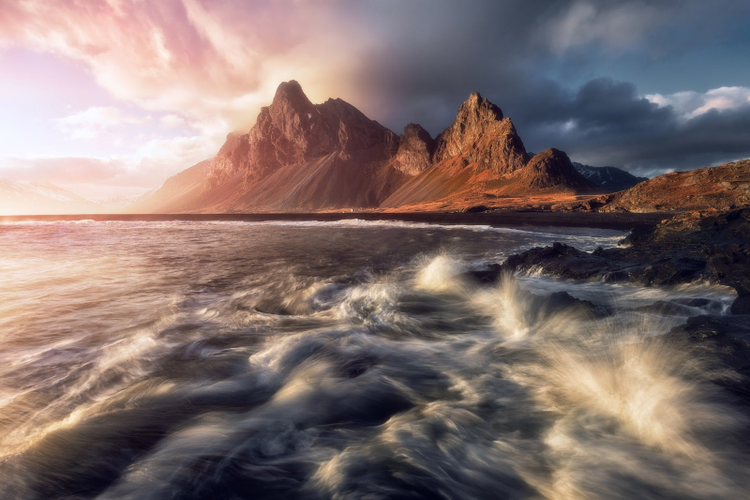
Mads Peter Iversen is a fine art landscape photographer whose cinematic images have earned him countless awards and hundreds of thousands of followers on Instagram.
Sapna Reddy got her start as a landscape photographer while snapping photos on her family camping trips and hikes. Mads Peter Iversen was a portrait photographer before a trip to Iceland convinced him that he and his camera belonged outdoors. Their work has since been featured in National Geographic, Sony, and Lonely Planet — racking up prestigious awards along the way.
Speaking to them both it’s clear that their love for the craft — and for each individual photo that they tirelessly nurture to completion — is central to their success.
Setting the stage
The journey begins with a mix of detailed planning and an open mind as they scout out the site of their next shoot. Lanscape photographers can spend hours — if not days — researching and traveling to a location, but there is no predicting how the elements will behave once they arrive.
“If I’m going to Yosemite, for instance, I have a general idea of what to expect there,” says Reddy, a radiologist based out of Northern California. “But nature is quirky.” Once on location, she becomes a light hunter, stalking sunrises and sunsets and the cracks in clouds just big enough for a few rays to slip through. “Every picture is a visual story, and light decides who takes center stage.”
Her next job is to choose the supporting cast. “I begin to look at all the accessory characters and think about how it would change the overall effect to include a particular tree, or perhaps a rock in the foreground,” she says.
Both Reddy and Iversen are drawn to the drama: the more movement and depth the better. For Iversen, a native of Denmark, this often takes the form of including himself or another person in his shot to add a sense of scale. Mist, craggy branches, and waterfalls also make frequent appearances in his work, which is shaped by his love of fantasy. “I don’t go in with a specific checklist of items to include in a shot, but I often find myself incorporating the same elements in my photos,” he says.
With the composition in place, Reddy and Iversen can set about harvesting every detail with their lens. Both describe spending a half hour or more photographing the same composition while the light changes, the wind comes and goes, and people move in and out of the frame. “I can easily end up with 20 to 50 versions of the same photo,” Iversen says.
The goal is not to take one shot that is better than all the rest. Rather, they are amassing the visual data they will need to assemble the final version later in the editing stage. As Reddy explains, “When I’m on location, I am shooting to do focus stacking. I am shooting to do exposure blending, to remove motion blur. And above all, I am shooting to remove people.”
Back at the computer
Once back in the editing room, the doctor is demanding of her photos. Not only must they be calming and healing — many will wind up on medical office walls — they must also serve as portals capable of transporting each viewer to the location of the shot. “I want my images to convey the feeling I had when I was standing there taking it,” she says. “I want to condense all five senses into a two-dimensional frame.”
To accomplish this, Reddy begins in Camera Raw, where she adjusts for global elements like exposure, color, and tone, applying the same changes to all the photos she plans to piece together to create her final image.
Lightroom, a favorite of landscape photographers, also gives users the option to batch edit, as well as the ability to rate individual images and do side-by-side comparisons. The app’s new feature “Best Photos” even uses machine learning to help select the strongest image from a group of similar photos — a handy tool when they all start running together.
Once Reddy switches to Photoshop is when the finessing begins. Nearly all her photos combine some element of focus stacking, in addition to combining photos taken at different times and with different exposures. This includes “Golden State,” her luminous interpretation of a sunset in Big Sur’s Calla Lily Valley.
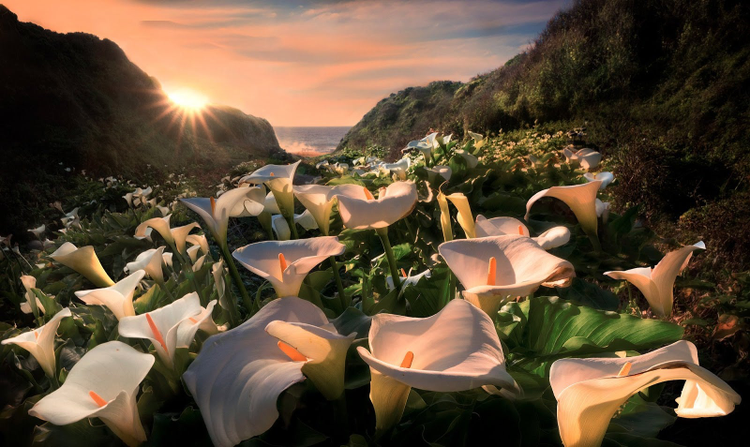
Sapna Reddy relied heavily on focus stacking to create this composite, entitled “Golden State.”
Reddy started work on the image by organizing her shots by their focal points in Photoshop before arranging them in layers and adding masks. From there, she pulled from the layers each flower, rock, and wave in the degree of focus required to build an image with compelling depth. This did not mean ensuring every flower was perfectly crisp. As she explains, “I wanted to convey a sense of depth as well.”
After focus stacking came the compositing. The sun star she captured and the glow on the lilies does not unfold together in nature. Only by painting just the right amount of light and shade on each petal was she able to piece together the final image. “I cannot imagine life as a photographer before Photoshop,” she says emphatically. “I simply cannot.”
Iversen, too, is a master of these techniques of compositing and focus stacking. In the image below, he stitched together eight photos, like Reddy using layers and masks to combine moments that occurred separately. “It’s about bringing in all the interesting elements that I caught in that period of time and leaving out the ones that are too distracting,” he says. Among those to land in the waste bin was “a very spiky sun flare,” which he decided stole too much attention from the image’s real star — the rock formation.
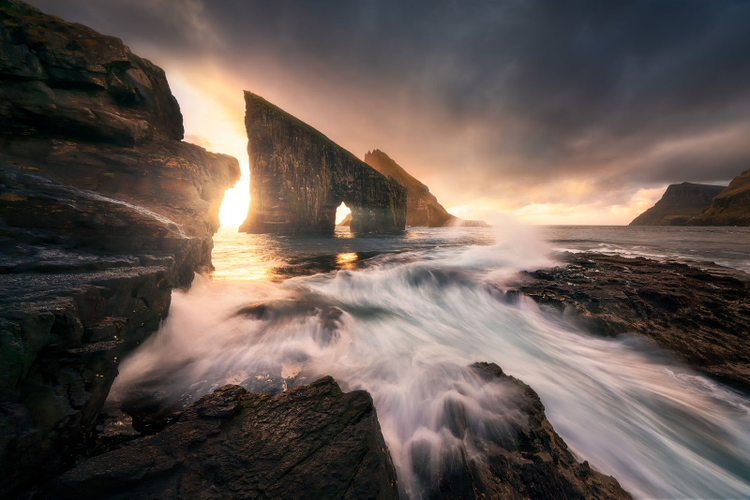
Mads Peter Iversen assembled this image taken in the Faroe Islands from eight different photographs, which he composited together using masks and layers in Photoshop.
After sundown
Landscape photography, already defined by its unpredictability, takes on even more challenges at night. Temperatures drop. Sites close. Stars rarely behave. But for those willing to brave the elements and the unknowns, night photography offers a whole new kind of canvas to play with, says Iversen. “It’s more artistic in the sense that what you photograph and edit rarely looks like what you saw with just your eyes.”
Take his shot of an ancient English abbey. Not only is the site closed at night, but it is all lit up. As a work around, Iversen photographed the ruins on a cloudy day and pieced it together with a night shot of the Milky Way to form an image that would otherwise be impossible.
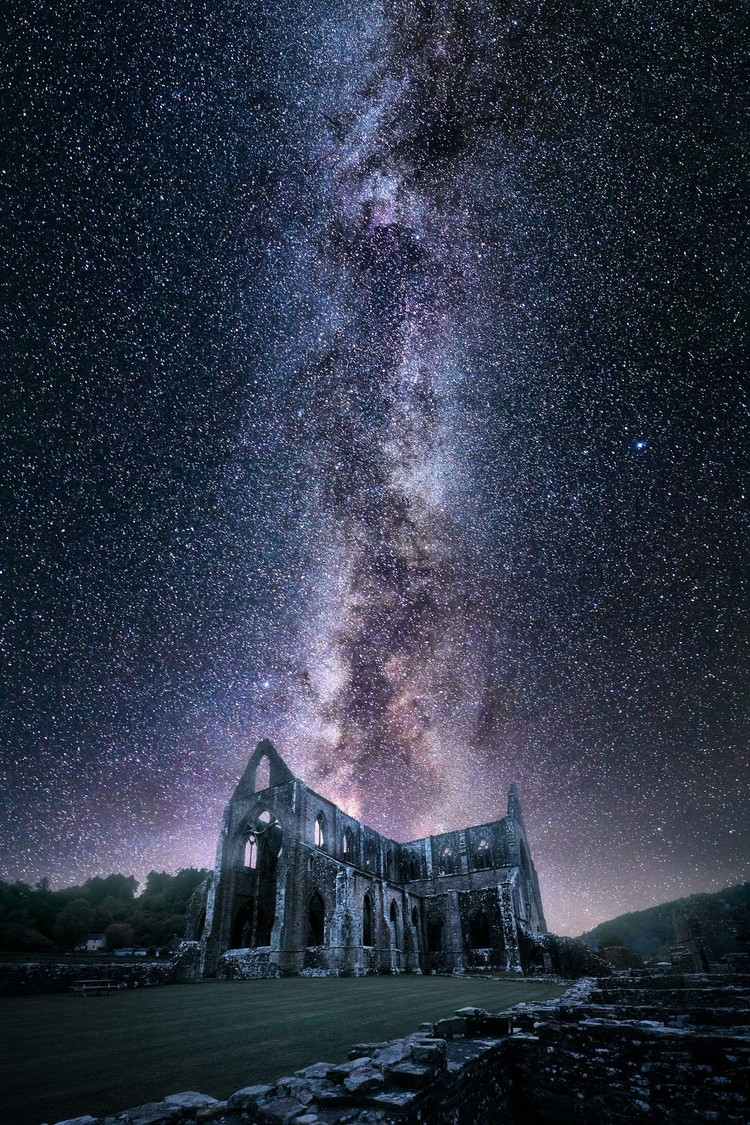
These ancient ruins are off-limits and lit up at night. Mads Peter Iversen was able to circumvent these issues by capturing the abbey on a cloudy day and combining it with a striking image of the Milky Way taken separately.
The same is true for Reddy’s image of the Northern Lights viewed from inside an ice cave. “Every image that you see of an ice cave with Aurora Borealis is a composite,” she explains. “There are no exceptions to that rule.” Like the English abbey, the ice caves are off-limits at night. So Reddy improvised. She shot from inside the caves during the day, using a timer so she could include herself, and caught the lights at night. “Putting it together was a lot of fun,” she says, describing the painstaking process of ensuring the light on each crest of ice was just the right shade of teal.
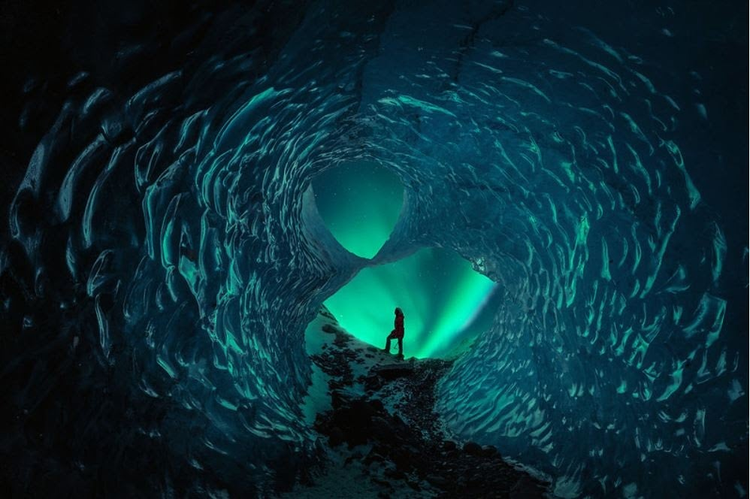
To create “Aurora,” Sapna Reddy combined shots she took during the day from within the ice caves, and those she captured at night when the Northern Lights were in full bloom.
Advice for beginners
When it comes to offering input to those just starting out, Reddy and Iversen agree: find friends to critique your work, but mute the critics.
“Don’t listen to the noise,” Iversen says. Instead, invest that energy into experimentation. “If you want to do what’s trending or popular, do it. Trying new things is how you will figure out what resonates with you.”
The other advice they both agree on? “Sleep on an image before you share it,” Reddy advises.
Finally, if you want to excel as a landscape photographer, you must master the tools at your disposal. “Every single one of my images is Photoshopped,” she explains. “And if you’re not using Photoshop, then you’re not doing the creative process justice.”
Check out Adobe’s guide to landscape photography for advice about composition, lenses, and locations. For a beginner’s guide to night photography, click here.